Even crashed and burnt, this barn-find Ferrari is worth millions
Now that the dust is settling (literally, it’s dry out here) at the Monterey auctions, we’re looking at nearly $400M in total sales, including over 150 vehicles sold for over $1M and the fifth-most expensive car ever sold at auction—the 1967 Ferrari 412P—for $30.255M. Significant, sure, but that sultry piece of rolling sculpture just didn’t bring much excitement or bidding on the block, and it sold at the price point everybody expected it to. Instead, there’s another piece of Ferrari racing lore that’s got people buzzing over the past three days. Something a little … rougher. It’s a 500 Mondial from 1954 (or at least it used to be), and it brought $1.875M.
That’s 17 percent over the car’s high estimate. Bent, burnt, incomplete, and ugly, is this another case of barn-find mystique, of emotions triumphing over financial sense? Or is it what publisher of the Hagerty Price Guide Dave Kinney calls “a savvy buy?”
Those questions are enough to make this 500 Mondial the most interesting sale at the 2023 Monterey auctions.
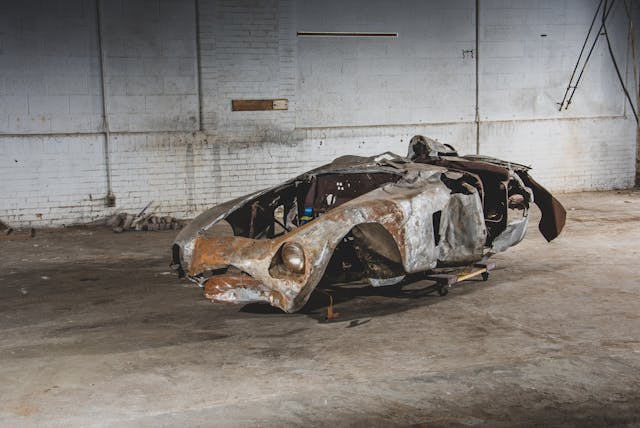
The 500 Mondial hails from the company’s early days of sports car racing success in the 1950s. Though everybody loves the roar of a V-12 Ferrari, the bark of a four-cylinder Mondial or Monza took plenty of checkered flags. Designed for Grand Prix racing by Aurelio Lampredi, Ferrari’s first four-cylinder engine powered the 500 F2 to World Championships in 1952 and 1953. Then, Ferrari fitted a detuned version of the alloy four into a sports car, called it the 500 Mondial (meaning “world” or “global”), and offered it to customers. Just 13 of these Spiders were originally built by Pinin Farina.
This Mondial, chassis #0406, is reportedly the second one. Sold new to a Milan-based dealer, it was driven by Franco Cortese (who had driven the first Ferrari to the company’s first victory in 1947) to second in class at the 1954 Coppa della Italiana. He drove it again to a fourth in class and 14th overall at the Mille Miglia, and after being rebodied by Scaglietti it finished eighth at Imola. More races at Imola, Oulton Park, Monza, and the Targa Florio followed, and by 1958 it had sold on to America, where it racked up some West Coast race appearances. By 1963 the Lampredi four-banger had been replaced by an American V-8 of unknown origin (it was just a cheap old race car at this point, remember) and then at an unknown time it crashed and suffered fire damage. Must have been some shunt, by the looks of it. After passing through a few owners, the battle-scarred Ferrari was sold to Florida real estate developer Walter Medlin in 1978.
Which brings us to the twenty-first century. In 2004, Hurricane Charley gave Florida a Category 4–sized smack and caused $16.9B in damage. Among the casualties was the barn housing Medlin’s 20 Ferraris (including the Mondial). The structure collapsed, raining debris down on the cars. Later relocated to Indiana and stored for another decade, the cars were finally brought out for sale in Monterey, arranged in a sort of diorama-like “as found” display during the preview, and given an appropriately fancy, auction catalog–worthy name: “The Lost & Found Collection.”
The group also included a 1956 410 Superamerica (sold for $2.8M) with missing trim, no steering wheel, and exhaust dragging the ground, as well as an alloy-bodied 275 GTB (sold for $3.3M) with great history but ghastly appearance. There was also a 365 GT 2+2 (sold for $118K) with the roof caved in, and a 308 GTB Vetroresina (sold for $78,400) with a busted windshield. Compared to the 500 Mondial, they all looked showroom fresh.

Aside from the mangled bodywork and frame, the Mondial comes with its factory-issued chassis plate as well as rear-axle corners, matching numbers five-speed gearbox, a 3.0-liter four-cylinder engine sourced from a similar 750 Monza, and a long future of shop bills.
That last one isn’t explicitly spelled out, but the people bidding on a $2M car aren’t stupid. They know a seven-figure restoration is the next step. Maybe there’s something reassuring about starting from the bottom.
“I know it sounds crazy, but this Mondial represents the ultimate blank slate,” says Kinney. “You’re buying a wadded-up pile of parts, so there can be no surprises. No panic about missing parts, because, frankly, most of them are. What about prior damage after taking the car apart? Not a problem here, it’s all damaged.”
As for the restoration, it’s certainly not something an owner can tackle with his buddies on weekends, but it’s still a relatively simple decision. “Take it to Ferrari for a full factory restoration or have any one of perhaps 25 name-brand shops restore it. There can be no corner-cutting, no ‘I got a friend in Des Moines who can get you a deal on chrome.’”
As they say, all it takes is money. “Remarkably similar to the price paid at the auction” is Kinney’s guess.

What’ll it be worth when it’s done? Well, old race-car prices can vary widely depending on history and originality, but 500 Mondials have sold before. One sold here last year for $2.1M, and that was a running and driving race winner. However, another one brought €3,717,500 ($4,162,485) in 2019, and in 2018 two others brought $5,005,000 and $4,455,000, respectively.
Once restored, chassis #0406 will also be eligible for top-level events like the Mille Miglia, and probably any concours up to and including Pebble Beach. That’ll be one hell of a before-and-after photo.
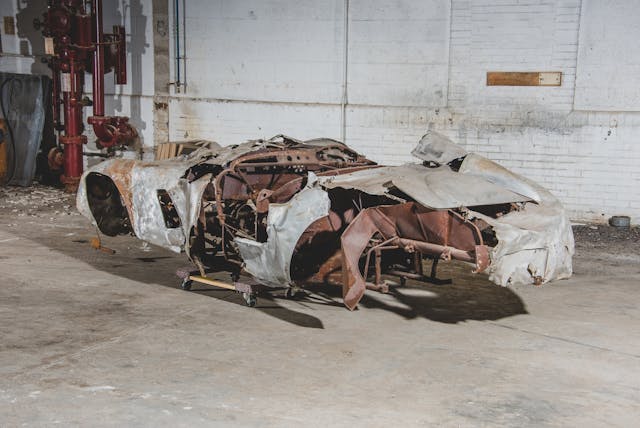
***
Check out the Hagerty Media homepage so you don’t miss a single story, or better yet, bookmark it. To get our best stories delivered right to your inbox, subscribe to our newsletters.

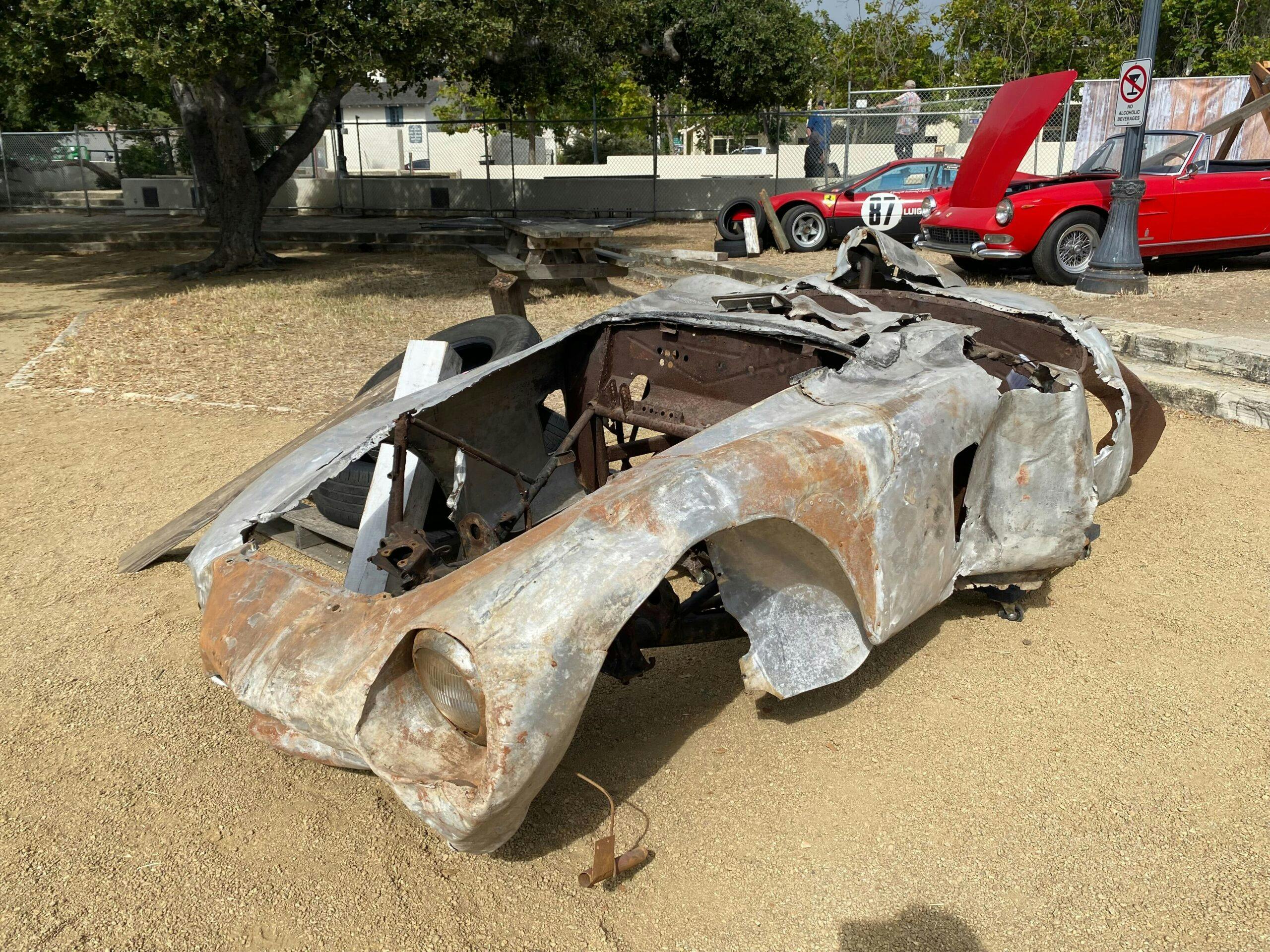
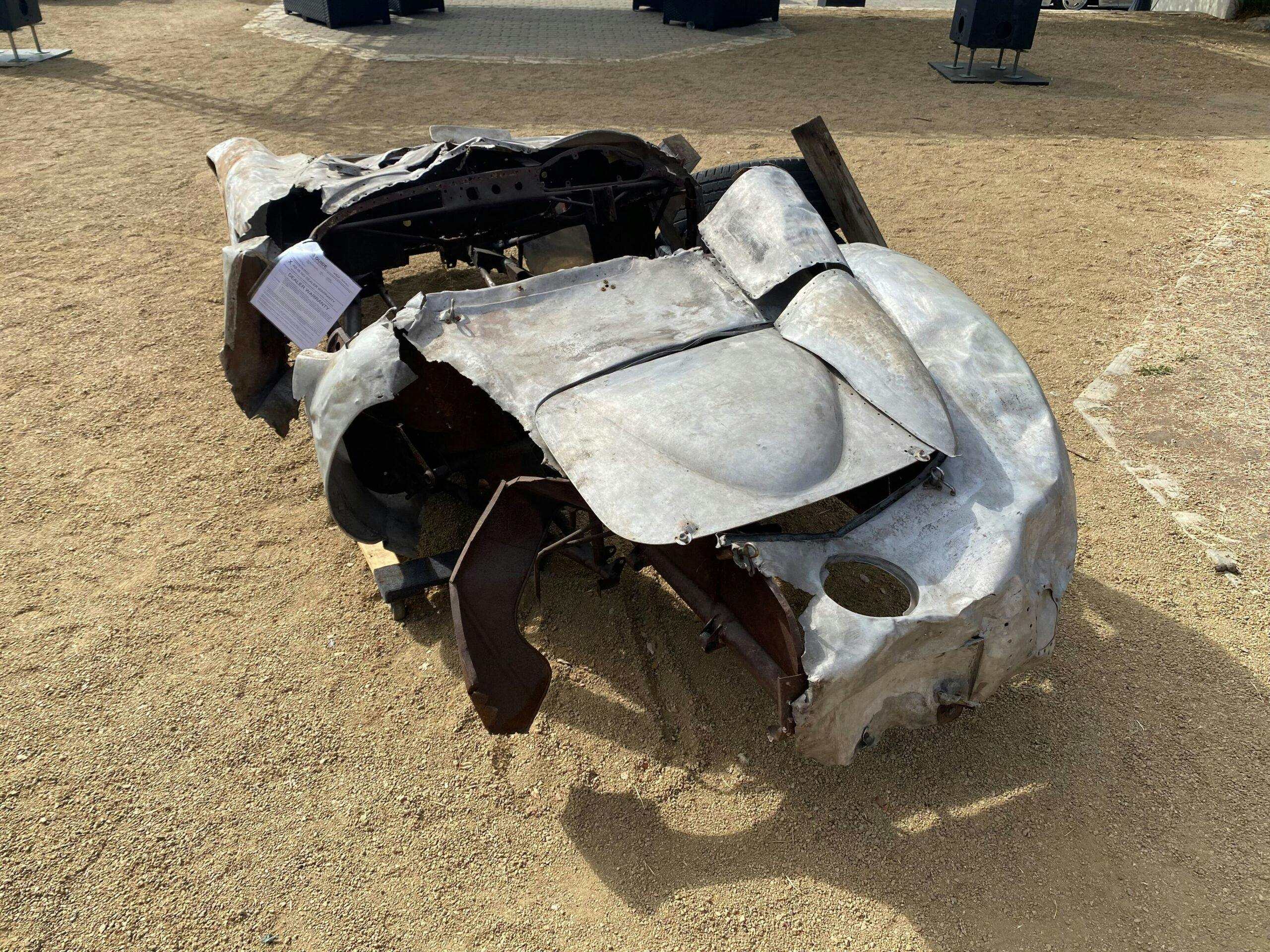
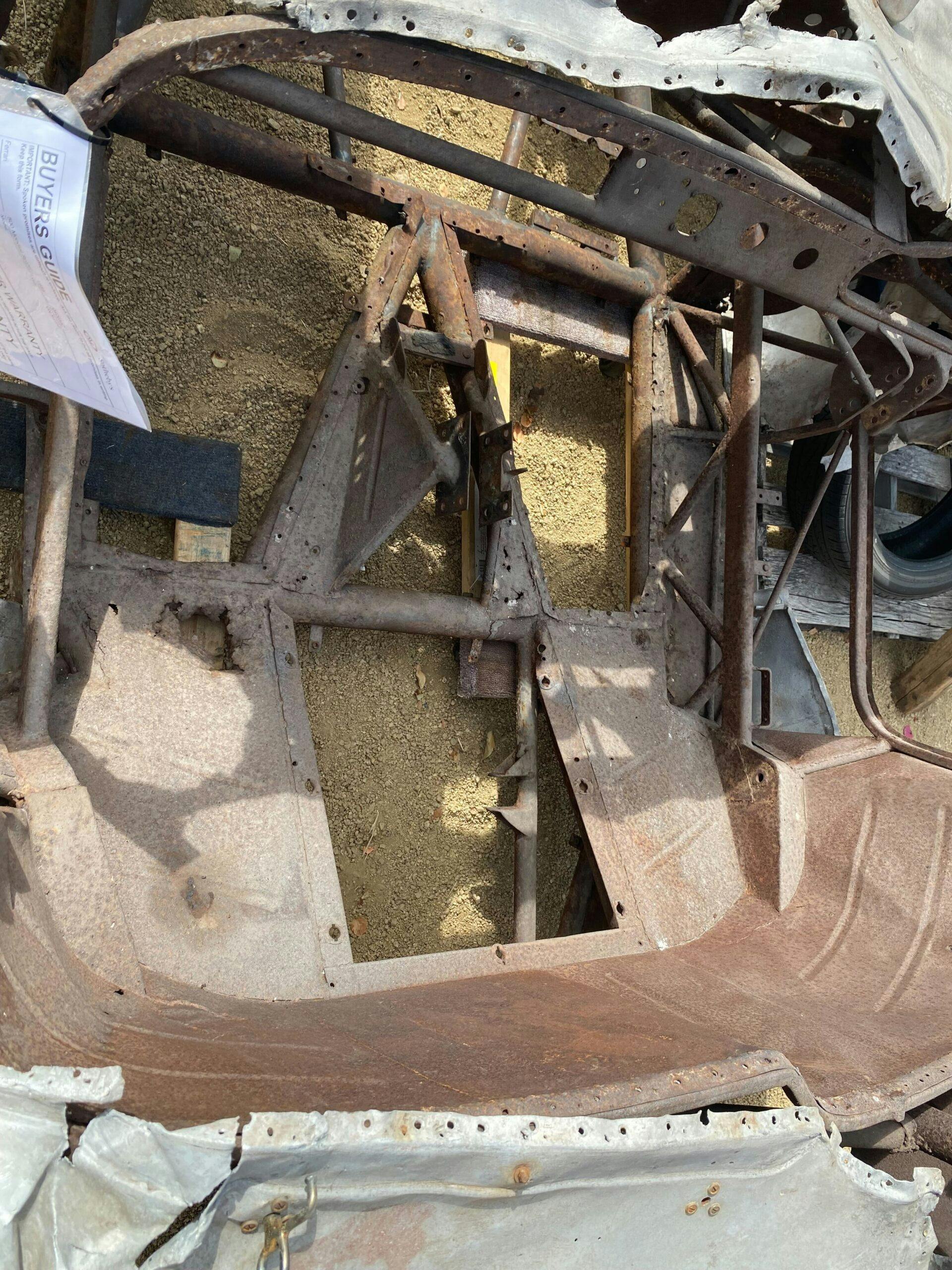


A “rebodied” 67 Camaro or Mustang (for example) tends to get some negative comments here (from the readers).
While this one won’t be a dynacorn repop, a spade is a spade?
[I personally don’t care either way, as long as something isn’t misrepresented as original]
Man, I’m definitely with snailish on this. I get that this isn’t just “any old Camaro or Mustang” – it’s a gennie 1-of-13 Ferrari racer with provenance – but sheesh, can’t we just proclaim it deceased and let it R.I.P.? Plow another $2 million into a pile that already cost $1.8 mil? So that maybe 2% (at best) of the result is OG? Really? I’m not sure I live in any universe where that makes sense…
As long as rich people are willing to spend big money on things like this pile and want to restore it, it is fine with me. That is how we make our money. Many people will make money from this project, and that is o.k.
The original body was replaced in the 1950’s. The original engine was replaced in the 1960’s. Does anybody know where they are? As this is a Ferrari, I suppose that’s possible. Be the first on your block to pay $2M for a chassis.
Calling what I can see in the photos “a chassis” is VERY generous, Tom! 😁
Sheer insanity.
Since when have cars been about cold logic and making sense? If it were, I wouldn’t own 6 cars. If I have the money and time, why not? If the car is a keeper, then who cares what it’s worth ultimately. Cars are about their stories and you would have a great story on your hands with this one. Is it a bit like Theseus’ ship? Yeah, but still…
You make a valid point, but in my mind, there is sense and there is nonsense, and this is definitely the latter…
They don’t have to make sense, but sensibility should take a forefront. While you may long for your exact first car, finding it years later, as a project, for the same price as a running/driving or restored one, is not sensible.
K-swap it!
Yard art for the rich
This is the side of collecting that I don’t see eye to eye with. The value of that scrap pile is that it is Ferrari Model X Serial Number Y. It’s all branding. There isn’t a real car there. The buyer didn’t see it and love with its lines, they certainly didn’t drive it and fall in love with its performance and handling. It is all about the tag assigned to that pile of scrap iron. Someone will rebuild it, 80% out of new, fabricated parts, and it will sell at auction for even more millions than what it was bought for, because it is Ferrari Model X Serial Number Y. If you could find a way to assign Ferrari Model X Serial Number Y to a Volkswagen Rabbit, it will sell for millions too
Ferrari (and other manufacturers) are missing a great moneymaker here. They should just find the serial numbers of significant vehicles that have definitely been destroyed, produce a “factory” serial plate with the same number and sell it to a “restorer” for a million bucks. The shop can then build a fake new vehicle, slap on the repro serial plate, then sell it as an authentic car. Sort of like restoring the Hindenburg with a new serial plate from Zeppelinworks.
Yet another reason not to let the valet park your car.
I don’t care what its providence is, IMHO it’s scrap.
If you say so!
As a piece of art I think it’s quite wonderful. Other than that, its just junk.
If I remember correctly (a big ‘if’ these days), there was a late 1950’s Testa Rossa that burned up when the barn it was stored in caught fire. The remains of the barn — including the TR — were bulldozed into a nearby gully, where the burnt, partially melted, twisted and rusting remains of the TR sat for about 20 years, until someone disinterred it in the 1980’s. By that point, what was left of the TR made this Mondial look like a concours queen. Yet it was ‘restored’ to complete, fully functioning, ‘authentic’ condition. As long as there is a chassis plate, and enough cash, any Ferrari can be resurrected…
Nothing new here, same with classic wooden boats. If you have the builders plate, a few bits and pieces and lots of $$, you have a restored original and a great story.